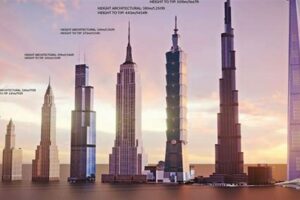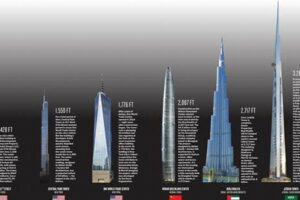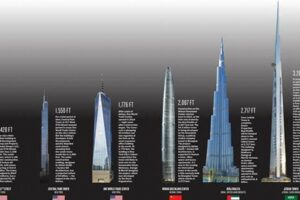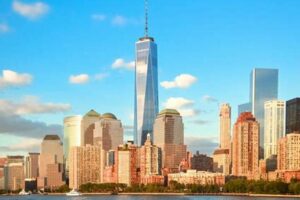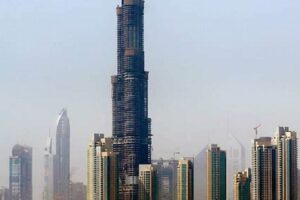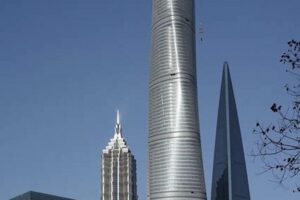The world’s tallest skyscraper in 2023 is the Burj Khalifa, standing at an impressive 828 meters (2,717 feet) tall. Located in Dubai, United Arab Emirates, this architectural marvel boasts 163 floors and offers breathtaking views of the city and beyond.
The Burj Khalifa is not just a skyscraper; it’s a symbol of human ingenuity and engineering prowess. Its construction, which began in 2004 and was completed in 2010, involved cutting-edge techniques and materials. The building’s unique design, with its tapering shape and intricate facade, has made it an iconic landmark and a popular tourist destination.
Beyond its architectural significance, the Burj Khalifa also offers a range of residential, commercial, and hospitality spaces. It houses luxury apartments, offices, a hotel, and various restaurants and entertainment venues. The building’s observation deck, located on the 124th floor, provides visitors with panoramic views of Dubai and its surroundings.
1. Height
The Burj Khalifa’s unmatched height is a defining characteristic that sets it apart and solidifies its status as the world’s tallest skyscraper in 2023. This extraordinary elevation has several implications:
- Vertical Dominance: The Burj Khalifa’s towering presence dominates the Dubai skyline, creating a majestic and awe-inspiring landmark. Its sheer height allows it to be visible from miles around, making it an iconic symbol of the city.
- Architectural Prowess: The construction of the Burj Khalifa pushed the boundaries of architectural engineering. It required innovative techniques and materials to achieve its unprecedented height, showcasing the advancements in modern construction.
- Elevated Views: The Burj Khalifa offers unparalleled views of Dubai and its surroundings from its observation deck on the 124th floor. Visitors can enjoy breathtaking panoramas that extend for miles, providing a unique perspective of the city’s vastness.
- Engineering Marvel: The Burj Khalifa’s height is a testament to the incredible ingenuity and engineering prowess of its creators. It represents a triumph of human ambition and a symbol of architectural achievement.
In conclusion, the unmatched height of the Burj Khalifa is not merely a numerical value but a culmination of architectural innovation, engineering excellence, and symbolic significance. It solidifies the Burj Khalifa’s position as the world’s tallest skyscraper in 2023 and establishes it as an architectural marvel that continues to inspire and captivate.
2. Floors
The Burj Khalifa’s 163 floors are an integral part of its status as the world’s tallest skyscraper in 2023. This exceptional number of floors has significant implications and multifaceted uses:
- Vertical Space Utilization: The 163 floors of the Burj Khalifa maximize vertical space, allowing for a diverse range of uses within a single structure. This efficient use of space optimizes land usage and caters to the varied needs of a modern metropolis.
- Mixed-Use Functionality: The Burj Khalifa’s floors accommodate a mix of residential, commercial, and hospitality spaces. This integrated approach creates a vibrant and self-contained vertical community where residents, businesses, and visitors can live, work, and enjoy amenities within the same building.
- Residential Diversity: The residential floors of the Burj Khalifa offer a range of luxury apartments, catering to diverse lifestyles and preferences. This vertical residential community fosters a sense of exclusivity and provides residents with unparalleled views of the city.
- Commercial Hub: The lower floors of the Burj Khalifa house premium office spaces, attracting businesses seeking a prestigious address and world-class facilities. This concentration of commercial activity contributes to Dubai’s position as a global business hub.
In conclusion, the 163 floors of the Burj Khalifa are not simply a quantitative measure but a testament to the building’s innovative design and multifaceted functionality. They enable the Burj Khalifa to serve as a vertical city, accommodating a diverse range of uses and creating a unique and dynamic urban environment.
3. Location
The location of the Burj Khalifa in Dubai, a global hub, plays a significant role in its status as the world’s tallest skyscraper in 2023. Dubai’s reputation as a center for commerce, tourism, and innovation has several implications:
- Economic Powerhouse: Dubai’s thriving economy, driven by sectors such as finance, real estate, and tourism, provides a solid foundation for the construction and maintenance of a megastructure like the Burj Khalifa. The city’s wealth and economic stability enable substantial investments in infrastructure and architectural marvels.
- Global Recognition: Dubai’s position as a global hub attracts attention and recognition from around the world. The Burj Khalifa, as an iconic landmark within this cosmopolitan city, benefits from increased visibility and prestige, solidifying its status as a globally renowned architectural achievement.
- Tourism Destination: Dubai’s status as a popular tourist destination contributes to the significance of the Burj Khalifa. The skyscraper is a major draw for tourists worldwide, eager to witness its grandeur and enjoy the city’s vibrant atmosphere. This influx of tourism generates revenue and further enhances Dubai’s reputation as a must-visit destination.
- Architectural Landscape: The Burj Khalifa has become an integral part of Dubai’s architectural landscape. Its presence has inspired other ambitious construction projects, transforming the city’s skyline and establishing Dubai as a hub for innovative and futuristic architecture.
In conclusion, the location of the Burj Khalifa in Dubai, a global hub, is not merely a geographical coincidence but a strategic choice that has contributed to its success and recognition. Dubai’s economic power, global prominence, tourism appeal, and architectural landscape have all played a vital role in shaping the Burj Khalifa’s status as the world’s tallest skyscraper in 2023.
4. Design
The unique and intricate facade of the Burj Khalifa is not merely an aesthetic consideration but an integral component of its status as the world’s tallest skyscraper in 2023. The facade plays a crucial role in several aspects that define the Burj Khalifa’s architectural significance:
Structural Support: The facade of the Burj Khalifa is not just a decorative element but also provides structural support to the building. The intricate design helps distribute the weight of the structure evenly, contributing to its overall stability and resistance to wind forces.
Wind Resistance: The facade’s design incorporates aerodynamic principles to minimize wind resistance. The angled panels and perforated surfaces reduce the impact of strong winds, ensuring the building’s structural integrity and reducing swaying.
Thermal Insulation: The facade is equipped with advanced thermal insulation materials that help regulate the building’s internal temperature. This reduces energy consumption and enhances occupant comfort, making the Burj Khalifa an environmentally conscious skyscraper.
Architectural Identity: The unique facade of the Burj Khalifa sets it apart from other skyscrapers and gives it a distinct architectural identity. The intricate patterns and lighting effects create a visually stunning landmark that has become synonymous with Dubai’s skyline.
In conclusion, the unique and intricate facade of the Burj Khalifa is not just an embellishment but an essential element that contributes to its structural integrity, environmental performance, and architectural significance. The facade’s design embodies the innovative spirit and engineering prowess behind the world’s tallest skyscraper in 2023.
5. Observation deck
The observation deck on the 124th floor of the Burj Khalifa offers breathtaking views of Dubai, further enhancing its significance as the world’s tallest skyscraper in 2023. This observation deck is not just a tourist attraction but an integral part of the building’s design and appeal:
- Unparalleled Views: The observation deck provides unparalleled panoramic views of Dubai’s cityscape, coastline, and surrounding desert. Visitors can witness the city’s architectural marvels, including the iconic Palm Jumeirah, from a unique and elevated perspective.
- Tourist Attraction: The observation deck has become a major tourist attraction, drawing visitors from around the world. It offers an unforgettable experience, allowing people to capture stunning photographs and create lasting memories.
- Architectural Landmark: The observation deck itself is an architectural landmark, adding to the overall appeal of the Burj Khalifa. Its design and location make it a recognizable feature of the building’s silhouette.
- Height Advantage: The observation deck’s position on the 124th floor takes full advantage of the Burj Khalifa’s height. It provides visitors with an unparalleled vantage point, allowing them to appreciate the scale and grandeur of the city below.
The observation deck on the 124th floor is more than just a viewing platform; it is an integral part of the Burj Khalifa’s identity as the world’s tallest skyscraper in 2023. It offers a unique and unforgettable experience, contributing to the building’s overall appeal and significance.
6. Mixed-use
The mixed-use nature of the Burj Khalifa, housing residential, commercial, and hospitality spaces, plays a significant role in its status as the world’s tallest skyscraper in 2023. This integration of diverse functions within a single structure offers several advantages and contributes to the building’s overall success:
- Vertical Community: The mixed-use design creates a vertical community where residents, businesses, and visitors can live, work, and enjoy amenities within the same building. This fosters a sense of convenience and self-sufficiency, reducing the need for extensive commuting and minimizing the environmental impact.
- Economic Viability: By combining residential, commercial, and hospitality spaces, the Burj Khalifa attracts a diverse tenant base, ensuring a stable income stream and reducing the risk associated with relying on a single type of occupancy. This mixed-use approach enhances the building’s economic viability and long-term sustainability.
- Efficient Land Use: The vertical integration of different functions maximizes land usage, particularly in densely populated urban areas like Dubai. By stacking residential, commercial, and hospitality spaces vertically, the Burj Khalifa optimizes space utilization and reduces the need for sprawling developments.
- Urban Planning: Mixed-use developments, such as the Burj Khalifa, promote walkability and reduce reliance on cars. By providing a range of amenities and services within the building, residents and visitors can access their daily needs without the need for extensive travel.
In conclusion, the mixed-use nature of the Burj Khalifa is not simply a convenience but a strategic design element that contributes to its status as the world’s tallest skyscraper in 2023. It fosters a vertical community, enhances economic viability, optimizes land use, and supports sustainable urban planning, making it a model for future high-rise developments.
7. Symbol
The Burj Khalifa’s status as the world’s tallest skyscraper in 2023 is not just a physical achievement but also a powerful symbol of Dubai’s ambition and economic growth. The decision to undertake such a monumental project reflects the city’s aspiration to push boundaries and establish itself as a global hub for commerce, tourism, and innovation.
The construction of the Burj Khalifa required significant financial resources and engineering expertise, demonstrating Dubai’s economic strength and its ability to attract top talent from around the world. The building’s completion marked a major milestone in Dubai’s transformation from a regional trading port to a modern metropolis and a magnet for international investment.
Moreover, the Burj Khalifa’s iconic presence in Dubai’s skyline has become synonymous with the city’s ambition and drive for progress. Its towering height and distinctive design have made it a global landmark, attracting visitors from around the world and solidifying Dubai’s position as a major tourist destination.
The connection between the Burj Khalifa and Dubai’s ambition and economic growth is evident in the building’s mixed-use design, which houses residential, commercial, and hospitality spaces. This integrated approach reflects Dubai’s commitment to creating a vibrant and self-sustaining urban environment that caters to the needs of its residents, businesses, and visitors.
In conclusion, the Burj Khalifa’s status as the world’s tallest skyscraper in 2023 is inextricably linked to Dubai’s ambition and economic growth. The building serves as a symbol of the city’s aspirations, its economic prowess, and its drive to establish itself as a global leader.
Frequently Asked Questions about the World’s Tallest Skyscraper 2023
The Burj Khalifa, an architectural marvel and a symbol of human ingenuity, has captured the world’s attention as the tallest building ever constructed. In this FAQ section, we address common questions and misconceptions surrounding this iconic skyscraper.
Question 1: What is the height of the Burj Khalifa?
The Burj Khalifa stands at an impressive 828 meters (2,717 feet) tall, making it the tallest structure ever built by humans.
Question 2: How many floors does the Burj Khalifa have?
The Burj Khalifa comprises 163 floors, offering ample space for a diverse range of uses, including residential, commercial, and hospitality.
Question 3: Where is the Burj Khalifa located?
The Burj Khalifa is located in Dubai, United Arab Emirates, a global hub for commerce, tourism, and innovation.
Question 4: When was the Burj Khalifa completed?
The construction of the Burj Khalifa began in 2004 and was completed in 2010, showcasing the advanced engineering capabilities of our time.
Question 5: What is the purpose of the Burj Khalifa?
The Burj Khalifa serves multiple purposes, including housing residential apartments, offices, a hotel, and various retail and entertainment venues.
Question 6: What unique features does the Burj Khalifa offer?
The Burj Khalifa boasts several unique features, such as an observation deck on the 124th floor, which provides breathtaking panoramic views of Dubai.
In conclusion, the Burj Khalifa, as the world’s tallest skyscraper in 2023, stands as a testament to human ambition, architectural prowess, and engineering excellence. Its iconic presence has transformed Dubai’s skyline and solidified its position as a global architectural destination.
Transition to the next article section
Tips Related to the World’s Tallest Skyscraper 2023
The Burj Khalifa, standing as the world’s tallest skyscraper in 2023, offers valuable insights and lessons that can be applied to various fields and disciplines. Here are some informative tips inspired by this architectural marvel:
Tip 1: Embrace Bold Ambitions: The Burj Khalifa’s construction epitomizes the power of setting audacious goals. It encourages us to challenge the boundaries of what is perceived as possible and strive for ambitious objectives.
Tip 2: Prioritize Innovation and Technology: The Burj Khalifa showcases the transformative impact of innovation and technology. It highlights the need to embrace cutting-edge solutions and techniques to push the limits of architectural design and engineering.
Tip 3: Value Sustainability: Despite its immense height, the Burj Khalifa incorporates sustainable design principles. It reminds us to prioritize eco-friendly practices and minimize environmental impact in all our endeavors.
Tip 4: Foster Collaboration: The Burj Khalifa’s construction involved a global team of architects, engineers, and construction professionals. It emphasizes the importance of collaboration, teamwork, and sharing expertise to achieve extraordinary outcomes.
Tip 5: Seek Inspiration from the Past: The Burj Khalifa draws inspiration from traditional Islamic architecture, blending modern design with cultural heritage. It encourages us to seek inspiration from the past while embracing contemporary innovations.
Summary: The Burj Khalifa, as the world’s tallest skyscraper in 2023, serves as a beacon of innovation, ambition, and collaboration. Its existence inspires us to set bold goals, embrace technology, prioritize sustainability, and foster teamwork to create architectural marvels that shape our world.
Transition to the article’s conclusion
Conclusion
The Burj Khalifa’s reign as the world’s tallest skyscraper in 2023 is a testament to human ingenuity, architectural prowess, and unwavering ambition. Its construction pushed the boundaries of engineering and design, creating an iconic landmark that has transformed Dubai’s skyline.
Beyond its physical stature, the Burj Khalifa symbolizes the economic growth and global aspirations of Dubai. It serves as a hub for commerce, tourism, and innovation, attracting businesses and visitors from around the world. The building’s mixed-use design fosters a vibrant and self-contained community, promoting sustainability and reducing environmental impact.
As we look to the future, the Burj Khalifa stands as a reminder of the transformative power of human endeavor. It inspires us to set bold goals, embrace innovation, prioritize collaboration, and strive for excellence in all our pursuits. The world’s tallest skyscraper in 2023 is not merely a building; it is a symbol of human ambition and a beacon of architectural achievement that continues to captivate and inspire.


